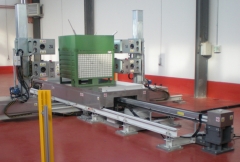Analysis of spectra is performed through a waste assay algorithm operating under the control of a proprietary software. The system work cycle is managed by the control software, which sends commands to the PLC. AURAS 3000 systems implement the “safety by design” principle to prevent any harm to operators and the system itself.The main components of AURAS 3000 are:
The container is first positioned by crane or forklift onto the heavy-duty platform. The operator starts the procedure through the user interface, selecting the container type from a pre-set table. This results in an automated adjustment of the detector height as required by the counting geometry. The platform is then pulled towards the measurement area, where the volume of the container is scanned through a sequence of steps (sub-sections).
AURAS 3000
FREE RELEASE WASTE ASSAY COUNTER
AURAS 3000 is an automated system designed to scan and characterise waste materials inside bags, boxes, drums, and B25 containers (density range: 100 - 2000 kg/m3). The system is equipped with up to four electro- or nitrogen-cooled HPGe detectors.
Additional Info
-
Main features:
- Worldwide standard system for waste characterization
- Versatile scanning geometry
- Sub-sections scanning procedure
- Detectors: up to four HPGe
- Free Release Assay of large waste containers up to 3 m3
- Max payload 3000 kg
- Quantitative assay of gamma emitters, and correlated scaling factors
- Activity and MDA reporting
- MDA (Cs-137): 0.0037 Bq/g (40 min)
Published in
Scanning systems
Download attachments:



